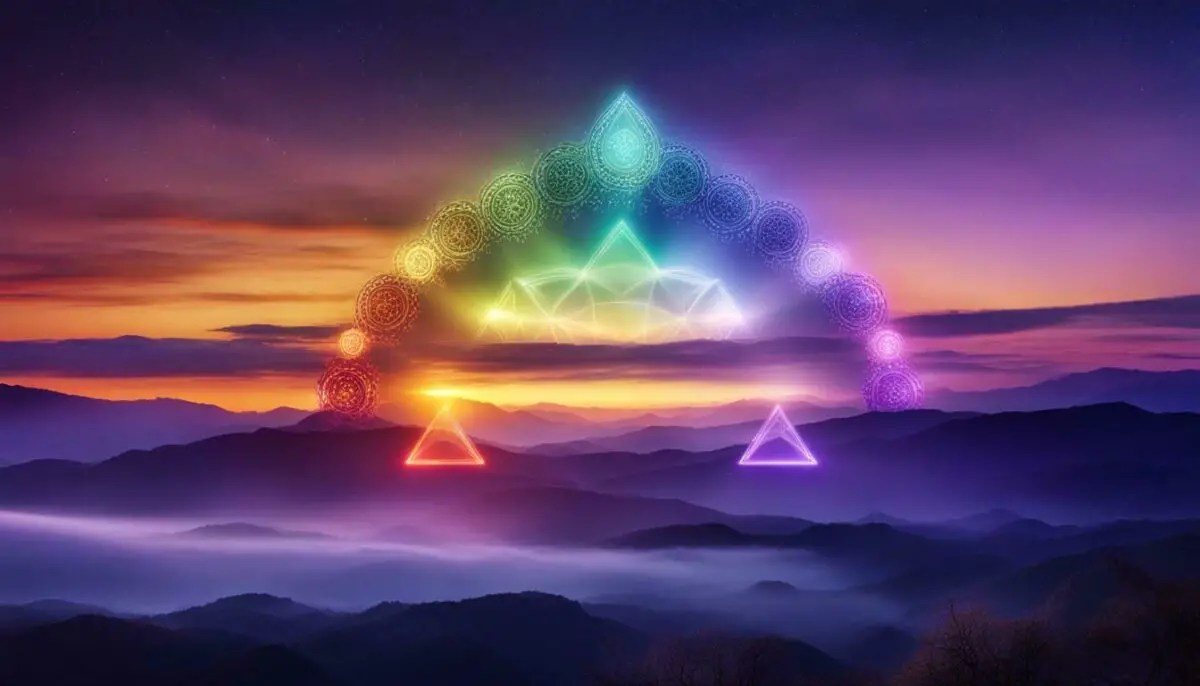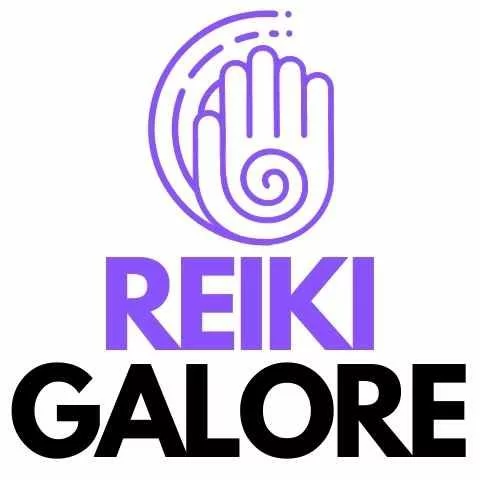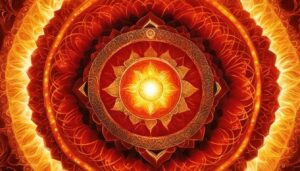Welcome to a journey that explores the vital connection between chakras and Reiki energy centers, uncovering the ancient healing power within. Chakra Reiki is a holistic healing practice that combines the concept of chakras with the energy healing technique of Reiki. Chakras are specific nerve bundles and internal organs that run from the base of the spine to the top of the head, and each plays a vital role in physical, emotional, and spiritual well-being. Reiki practitioners channel universal life force energy into a person’s body to restore balance and promote healing. By focusing on the chakras, practitioners can address blockages or imbalances and help individuals take an active role in their own healing process.
Key Takeaways:
- Chakra Reiki combines chakras and the energy healing technique of Reiki.
- Chakras are specific nerve bundles and internal organs that contribute to overall well-being.
- Reiki practitioners use universal life force energy to restore balance and promote healing.
- Focusing on chakras helps address blockages or imbalances in the body.
- Chakras and Reiki are interconnected, enhancing energy flow and balancing the chakra system.

Understanding Chakras: Key to Holistic Healing
Before diving into the realm of Reiki energy centers, it is essential to understand the fundamental concept of chakras and their role in achieving holistic healing. Chakras are specific nerve bundles and internal organs that run from the base of the spine to the top of the head. There are seven main chakras, each associated with specific emotions and bodily functions. These energy centers play a vital role in physical, emotional, and spiritual well-being.
Chakras contribute to maintaining energy balance and flow within the body, leading to overall well-being. When the chakras are in harmony, energy moves freely throughout the body, promoting health and vitality. However, blockages or imbalances in the chakras can disrupt the flow of energy, resulting in physical, emotional, and psychological symptoms.
By understanding the chakras and their significance, individuals can take an active role in their own healing process. Chakra imbalances can be addressed through various techniques, such as Reiki, which channels universal life force energy into the body to restore balance and promote healing. Reiki enhances the flow of energy through the chakra system, helping to clear blockages and optimize energy flow. This holistic approach to healing recognizes the interconnectedness of the mind, body, and spirit.
Through a combination of Reiki, meditation, yoga, and other complementary practices, individuals can achieve chakra balancing and experience the benefits of holistic healing. By restoring harmony and balance to the chakras, individuals can enhance their overall well-being and achieve optimal energy flow throughout their body.
| Benefits of Understanding Chakras in Holistic Healing: |
|---|
| • Promotes overall well-being of mind, body, and spirit |
| • Enhances energy balance and flow |
| • Addresses physical, emotional, and psychological symptoms |
| • Provides a foundation for Reiki and other healing practices |
The Power of Reiki: Channeling Universal Life Force Energy
Reiki, a powerful ancient healing technique, allows skilled practitioners to tap into universal life force energy, bringing forth its transformative power for spiritual and physical healing. By channeling this energy, Reiki practitioners can facilitate the restoration of balance and harmony within the body’s energy centers, known as chakras. Through the gentle placement of hands on or near the chakras, Reiki energy flows to where it is needed most, helping to clear blockages, release stagnant energy, and promote overall well-being.
Reiki has been recognized as a form of energy healing that goes beyond traditional medicine, offering a holistic approach to well-being. It is a spiritual healing modality that is not limited by time, space, or distance. Reiki practitioners understand that energy flows through all living things, and by tapping into this universal life force energy, they can promote healing on a deep level.
Reiki practitioners undergo a process of attunement and training to enhance their ability to connect with and channel this healing energy. Through symbols and hand positions, they direct the flow of energy to areas of the body that require healing. Each chakra, with its unique characteristics and functions, can be addressed individually to restore balance and optimize the flow of energy.
Reiki Practitioners: Guided by Intuition and Spiritual Connection
Reiki practitioners are guided by their intuition and a deep spiritual connection to the energy they are channeling. They work with the client’s energy field and chakras, using their hands as a conduit to facilitate the flow of healing energy. This intuitive approach allows the practitioner to address not only physical symptoms but also emotional and energetic imbalances.
Reiki can be a transformative experience, providing relaxation, stress relief, and a sense of overall well-being. It is a complementary therapy that can be used alongside traditional medical treatments, enhancing the healing process and supporting the body’s natural ability to heal itself.
| Benefits of Reiki | How Reiki Works |
|---|---|
| Relaxation and stress relief | Channels universal life force energy |
| Improved sleep quality | Clears energy blockages |
| Enhanced emotional well-being | Promotes balance and harmony |
| Supports the body’s natural healing processes | Connects practitioner and client on a deep spiritual level |
Reiki offers a gentle, non-invasive way to promote healing and restore balance within the chakra system. Its transformative power, combined with the profound connection to universal life force energy, makes Reiki a valuable tool for spiritual and physical well-being. Whether used as a complementary therapy or as a self-care ritual, Reiki has the potential to bring about profound healing and transformation in the lives of both practitioners and recipients.
Chakras and Reiki: The Interconnection and Balancing
Chakras and Reiki are intricately intertwined, with Reiki serving as a powerful tool for balancing and enhancing the natural energy flow within the chakra system. Chakras, the energy centers in our bodies, play a vital role in our physical, emotional, and spiritual well-being. When these energy centers become blocked or imbalanced, it can manifest in various physical and emotional symptoms.
During a Reiki session, the practitioner works with each chakra using specific hand positions and symbols to channel healing energy into the body. This gentle yet effective technique allows for the release of blockages and the restoration of energy flow within the chakras. By addressing these imbalances, Reiki helps to promote overall well-being and facilitate the body’s natural healing process.
One of the key aspects of balancing chakras with Reiki is the use of symbols. These Reiki symbols hold specific meanings and are used by practitioners to enhance the healing process. They serve as powerful tools to amplify the energy within the chakras and can be applied directly to the body or visualized during a Reiki session.
The Interconnection of Chakras and Reiki Symbols
| Chakra | Reiki Symbol |
|---|---|
| Root Chakra | Hon Sha Ze Sho Nen – Symbol of Connection |
| Sacral Chakra | Sei He Ki – Symbol of Harmony |
| Solar Plexus Chakra | Cho Ku Rei – Symbol of Power |
| Heart Chakra | Shika Sei Ki – Symbol of Love |
| Throat Chakra | Hon Sha Ze Sho Nen – Symbol of Communication |
| Third Eye Chakra | Sei He Ki – Symbol of Intuition |
| Crown Chakra | Cho Ku Rei – Symbol of Enlightenment |
Each Reiki symbol corresponds to a specific chakra, helping to enhance the healing and balancing process. By incorporating these symbols into a Reiki practice, practitioners can create a deeper connection with the energy centers and facilitate the restoration of balance within the chakra system.
Chakras and Reiki work hand in hand to promote healing, balance, and well-being. Whether you are seeking physical, emotional, or spiritual healing, the combination of these ancient practices can provide a powerful tool for self-discovery and personal growth. By embracing the interconnection between chakras and Reiki, you can tap into the profound healing power within you and create a harmonious flow of energy in your life.
Exploring the Seven Main Chakras and Their Functions
Each of the seven main chakras plays a significant role in maintaining our bodily functions and emotional well-being, and imbalances can lead to a range of physical symptoms and emotional disharmony. Understanding these chakras and their functions is crucial for achieving overall balance and harmony within ourselves.
1. The Root Chakra (Muladhara): This chakra is located at the base of the spine and is associated with our sense of stability, security, and grounding. When imbalanced, it can lead to feelings of insecurity, fear, and physical ailments such as lower back pain or digestive issues.
2. The Sacral Chakra (Svadhisthana): Located in the lower abdomen, this chakra relates to our creativity, sexuality, and emotional well-being. Imbalances in this chakra can manifest as a lack of inspiration, difficulty expressing emotions, or reproductive issues.
3. The Solar Plexus Chakra (Manipura): Situated in the upper abdomen, this chakra is linked to our personal power, confidence, and self-esteem. When imbalanced, it can result in low self-worth, lack of motivation, and digestive disorders.
| Chakra | Location | Main Functions | Symptoms of Imbalance |
|---|---|---|---|
| Root Chakra | Base of the spine | Stability, security, grounding | Insecurity, fear, lower back pain |
| Sacral Chakra | Lower abdomen | Creativity, sexuality, emotions | Lack of inspiration, emotional suppression, reproductive issues |
| Solar Plexus Chakra | Upper abdomen | Personal power, confidence, self-esteem | Low self-worth, lack of motivation, digestive disorders |
4. The Heart Chakra (Anahata): Located in the center of the chest, this chakra is associated with love, compassion, and emotional healing. Imbalances can result in difficulty in giving and receiving love, feelings of resentment, or heart-related issues.
5. The Throat Chakra (Vishuddha): Situated in the throat, this chakra governs our communication, self-expression, and ability to speak our truth. When imbalanced, it can lead to difficulties in expressing ourselves, fear of judgment, or throat-related health problems.
6. The Third Eye Chakra (Ajna)
The Third Eye Chakra, located in the center of the forehead, is associated with intuition, insight, and spiritual awareness. When this chakra is imbalanced, it can result in a lack of clarity, difficulty making decisions, or disruptions in sleep patterns.
- The Root Chakra (Muladhara): Stability, security, grounding.
- The Sacral Chakra (Svadhisthana): Creativity, sexuality, emotions.
- The Solar Plexus Chakra (Manipura): Personal power, confidence, self-esteem.
7. The Crown Chakra (Sahasrara): Situated at the top of the head, this chakra represents our connection to the divine, spiritual enlightenment, and higher consciousness. Imbalances in this chakra can manifest as a lack of purpose, spiritual disconnection, or feelings of isolation.
By understanding the functions of each chakra, we can identify where imbalances may be occurring and work towards restoring harmony within ourselves. Reiki, along with other holistic practices, can help clear blockages and restore the flow of energy, promoting overall well-being.
Addressing Chakra Imbalances with Reiki Healing
Through the power of Reiki, chakra imbalances can be effectively addressed, promoting healing and restoring harmony within the energy centers. Chakras are the energy centers in our body that play a crucial role in our overall well-being. When these chakras become blocked or imbalanced, it can manifest as physical, emotional, or psychological symptoms.
During a Reiki session, the practitioner works with each chakra, focusing their healing energy to clear any blockages and restore balance. This is done through various hand positions and the use of specific Reiki symbols. By directing the universal life force energy to the affected energy centers, Reiki helps to activate and optimize their function.
In addition to clearing blockages, Reiki can be enhanced by incorporating other elements such as crystals and aromatherapy. Crystals possess unique vibrational properties that can complement and amplify the healing process. They can be placed on or near the chakras to facilitate energy flow and promote balance. Aromatherapy, on the other hand, utilizes the therapeutic properties of essential oils to support emotional and physical well-being.
Using Crystals for Chakra Healing:
| Chakra | Crystal |
|---|---|
| Root Chakra | Red Jasper |
| Sacral Chakra | Carnelian |
| Solar Plexus Chakra | Citrine |
| Heart Chakra | Rose Quartz |
| Throat Chakra | Aquamarine |
| Third Eye Chakra | Amethyst |
| Crown Chakra | Clear Quartz |
Meditation and yoga poses are also effective tools for chakra balancing. By incorporating specific poses and breathing techniques, we can activate and stimulate the energy flow in our chakras. Regular practice of these techniques can help restore harmony within the chakra system and promote overall well-being.
Whether used as a complementary therapy for pain management or as a self-care ritual for relaxation, Reiki offers a holistic approach to healing. By addressing chakra imbalances through the power of Reiki, we can tap into the ancient healing wisdom and promote harmony within our energy centers.
Enhancing Reiki with Crystals, Aromatherapy, and More
Beyond the core practice of Reiki, the healing power can be further amplified by incorporating crystals, aromatherapy, and other complementary tools. These additional elements work synergistically with Reiki to enhance the energetic healing process and promote overall well-being.
Crystals, for example, possess unique vibrational frequencies that can align with and support the energy centers of the body. By placing specific crystals on or around the body during a Reiki session, they can assist in clearing blockages, harmonizing chakras, and amplifying the healing energy. For instance, amethyst is often used to promote spiritual growth and balance the crown chakra, while rose quartz is known for its ability to heal emotional wounds and open the heart chakra.
Aromatherapy is another powerful tool that can be integrated into Reiki sessions. Essential oils derived from plants contain concentrated aromatic compounds that can positively impact physical, emotional, and spiritual well-being. Through their scent and therapeutic properties, oils such as lavender, frankincense, and eucalyptus can help relax the body, calm the mind, and uplift the spirit. By diffusing these oils or applying them topically, they can enhance the healing experience and create a nurturing environment.
Table: Crystals and Their Associated Chakras
| Crystal | Associated Chakra |
|---|---|
| Amethyst | Third Eye, Crown |
| Rose Quartz | Heart |
| Citrine | Solar Plexus |
| Carnelian | Sacral |
| Garnet | Root |
Other complementary tools that can be used in conjunction with Reiki include sound therapy, color therapy, and sacred geometry. Sound therapy utilizes specific frequencies and vibrations to restore harmony within the body, while color therapy incorporates the use of specific colors to balance and energize the chakras. Sacred geometry, on the other hand, utilizes geometric patterns with inherent energetic qualities to facilitate healing and spiritual transformation.
By incorporating these additional tools into Reiki sessions, practitioners can create a holistic and immersive healing experience for their clients. The combination of Reiki, crystals, aromatherapy, and other complementary modalities allows for a deeper and more profound connection to the energetic healing process, supporting the restoration of balance and overall well-being.
Chakra Balancing through Meditation and Yoga
Meditation and yoga offer powerful practices to harmonize and balance the chakras, fostering a state of inner peace and optimal energy flow. These ancient techniques provide a holistic approach to chakra healing, allowing individuals to tap into their body’s inherent wisdom and restore equilibrium.
Through focused meditation, one can cultivate awareness of the chakras and their energy centers within the body. By directing attention to each chakra, practitioners can identify imbalances or blockages and work towards clearing them. This process involves visualizing the chakra’s specific color and repeating corresponding mantras or affirmations to activate and harmonize the energy center.
Yoga poses, or asanas, further support chakra balancing by engaging the physical body and stimulating energy flow. Each asana correlates to a specific chakra, providing targeted support for its associated functions. For example, backbends, such as the Cobra pose, can open the heart chakra, while forward bends, like the Child’s pose, can calm and center the root chakra.
Incorporating specific breathing techniques, or pranayama, can also enhance chakra balancing during meditation and yoga. Alternate nostril breathing, for instance, helps balance the left and right energies of the body, promoting overall balance and harmony within the chakra system.
| Chakra | Yoga Pose |
|---|---|
| Root Chakra | Mountain Pose (Tadasana) |
| Sacral Chakra | Bow Pose (Dhanurasana) |
| Solar Plexus Chakra | Warrior II Pose (Virabhadrasana II) |
| Heart Chakra | Camel Pose (Ustrasana) |
| Throat Chakra | Shoulderstand (Sarvangasana) |
| Third Eye Chakra | Child’s Pose (Balasana) |
| Crown Chakra | Headstand (Sirsasana) |
By regularly incorporating meditation and yoga into your routine, you can create a sacred space for chakra balancing and personal growth. These practices offer a journey of self-discovery, enabling you to connect deeply with your body, mind, and spirit. Unleash the power of meditation and yoga to restore harmony within your chakra system and embrace a more vibrant and balanced life.
Reiki as an Effective Technique for Pain Management
Reiki has shown great promise as an effective technique for pain management, providing relief for individuals, including those facing the challenges of cancer. With its holistic approach to healing, Reiki aims to restore balance and promote overall well-being. By channeling universal life force energy into the body, Reiki practitioners can address chakra imbalances and clear blockages, which can often contribute to physical discomfort and pain.
During a Reiki session, the practitioner focuses on the affected energy centers, working with specific hand positions and symbols to facilitate the flow of healing energy. This helps to alleviate pain and promote the body’s natural ability to heal itself. Studies have shown that Reiki can be especially beneficial in managing pain associated with cancer. It complements conventional medical approaches and can be integrated into a comprehensive pain management plan.
In addition to addressing physical pain, Reiki also helps individuals manage the emotional and psychological aspects of their pain. The deeply relaxing nature of Reiki promotes a sense of calm and reduces stress and anxiety, which are often associated with chronic pain. By enhancing relaxation and well-being, Reiki provides a holistic approach to pain management that encompasses the body, mind, and spirit.
It is important to note that Reiki should always be used as a complement to conventional medical treatment. It is essential to consult with a healthcare professional before incorporating Reiki into a pain management plan, particularly for individuals with cancer or other medical conditions. Receiving Reiki from a certified practitioner can provide a safe and supportive environment for pain management and overall healing.
| Benefits of Reiki for Pain Management |
|---|
| Alleviates physical pain |
| Promotes relaxation and reduces stress |
| Complements conventional medical approaches |
| Addresses emotional and psychological aspects of pain |
Embracing Reiki as a Self-Care Ritual for Relaxation
Embracing Reiki as a self-care ritual allows us to take a moment for ourselves, decreasing stress, anxiety, and fostering a deep sense of relaxation. In today’s fast-paced world, it’s essential to carve out time for self-care, and Reiki provides an effective and accessible way to do so.
During a Reiki session, the practitioner creates a calm and serene environment, using gentle touch or hovering their hands slightly above the body in specific hand positions. This non-invasive technique allows the universal life force energy to flow through the body, promoting a state of deep relaxation and balance.
“Reiki is like a gentle embrace for the soul. It helps to release tension and negative energy, while restoring harmony within the mind, body, and spirit.”
As the Reiki energy flows through the body, it works to clear any blockages or imbalances within the chakras, which are the energy centers responsible for our overall well-being. By bringing these energy centers back into alignment, Reiki can help to alleviate physical discomfort, calm emotional turbulence, and bring clarity to the mind.
Embracing Reiki as a self-care ritual can be as simple as finding a quiet space, closing your eyes, and placing your hands on your body, allowing the healing energy to flow. Whether you choose to practice Reiki on yourself or seek the guidance of a certified Reiki practitioner, the benefits of this ancient healing technique can be profound and transformative.
| Benefits of Reiki as a Self-Care Ritual |
|---|
| 1. Decreased stress and anxiety |
| 2. Improved sleep and relaxation |
| 3. Enhanced emotional well-being |
| 4. Physical pain relief |
| 5. Increased energy and vitality |
| 6. Heightened self-awareness and intuition |
By incorporating Reiki into your self-care routine, you are prioritizing your well-being and taking an active role in nurturing and balancing your mind, body, and spirit. So why not treat yourself to a moment of relaxation and healing? Embrace Reiki as a self-care ritual and allow its transformative energy to guide you on a journey of self-discovery and inner peace.
Conclusion
In conclusion, the profound connection between Reiki and the Energy Centers highlights the significance of holistic healing, recognizing the role of chakras and the ancient healing power that Reiki offers. Chakra Reiki combines the concept of chakras, which are specific nerve bundles and internal organs, with the energy healing technique of Reiki. Each chakra plays a vital role in physical, emotional, and spiritual well-being, and by focusing on these energy centers, individuals can take an active role in their own healing process.
During a Reiki session, practitioners channel universal life force energy into the body, restoring balance and promoting healing. By working with each chakra using various hand positions and symbols, practitioners address blockages or imbalances, allowing enough time for healing to take place. This interconnected relationship between chakras and Reiki enhances the flow of energy through the chakra system, optimizing overall well-being.
There are seven main chakras, each associated with specific emotions and bodily functions. Imbalances in these chakras can manifest in physical, emotional, and psychological symptoms. Reiki can be used as an effective technique to address these imbalances, clearing any blockages and restoring balance within the energy centers. Practitioners may incorporate tools such as crystals or aromatherapy to enhance the healing process.
In addition, chakra balancing can be achieved through meditation and yoga poses. The practice of Reiki as a complementary therapy has shown effectiveness in pain management, especially for cancer patients, alongside conventional medical approaches. Reiki can also be embraced as a self-care ritual, decreasing stress and anxiety while promoting relaxation, leading to overall well-being.
The ancient healing power of Reiki, combined with the recognition of chakras as vital energy centers, offers a holistic approach to healing and well-being. By understanding and embracing this profound connection, individuals can unlock the potential for balance, harmony, and self-healing within themselves.




